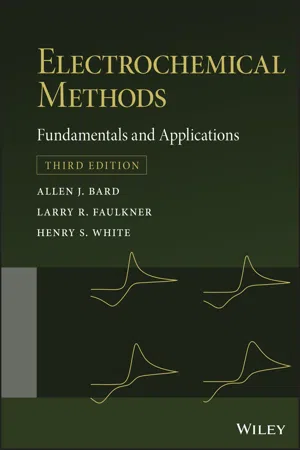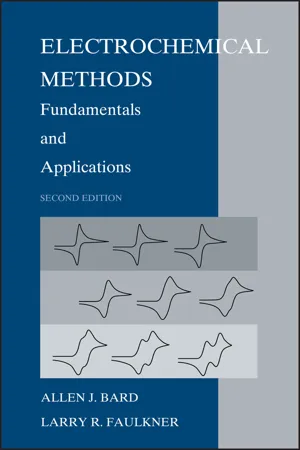Chemistry
Cell Potential
Cell potential, also known as electromotive force, is a measure of the potential difference between the two electrodes of an electrochemical cell. It represents the driving force for the movement of electrons through the cell. Cell potential is a key concept in understanding the behavior of electrochemical cells and is crucial in determining the feasibility and direction of redox reactions.
Written by Perlego with AI-assistance
Related key terms
1 of 5
12 Key excerpts on "Cell Potential"
- eBook - PDF
Electrochemical Methods
Fundamentals and Applications
- Allen J. Bard, Larry R. Faulkner, Henry S. White(Authors)
- 2022(Publication Date)
- Wiley(Publisher)
61 2 Potentials and Thermodynamics of Cells In Chapter 1, we focused on potential as an electrochemical variable. Here we look more closely at the physical meaning of potential, the origins of potential differences, and access, through potential, to chemical information. Initially, we will approach these matters through thermodynamics, which will teach us that potential differences manifest free energy changes. That linkage will open a path to chemical information through electrochemical measurements. Subsequently, we will explore the physical mechanism by which potential differences are established, and we will gain insights relevant to the measurement and control of potential. 2.1 Basic Electrochemical Thermodynamics 2.1.1 Reversibility Thermodynamics strictly applies only to systems at equilibrium, which involves the idea that a process can move readily in opposite directions from the equilibrium position. The adjective reversible relates to this core idea; however, the word carries several different, but related, mean-ings. We distinguish three of them now. (a) Chemical Reversibility Consider the electrochemical cell shown in Figure 1.1.1 b : Pt ∕ H 2 ∕ H + , Cl − ∕ AgCl ∕ Ag (2.1.1) Experimentally, one finds that the difference in potential between the silver wire and the platinum wire is 0.222 V when all substances are in their standard states. - Avinash Balakrishnan, K.R.V. Subramanian(Authors)
- 2014(Publication Date)
- CRC Press(Publisher)
The force on the electrons causing them to move is referred to as electromotive force or EMF (E). One can measure the magnitude of the EMF causing electron flow by measuring the voltage. Electricity is generated due to the electric potential difference between the two electrodes and this difference in potential is called the Cell Potential. This electric potential varies with temperature, pressure, and concentration of the cell. As mentioned earlier, these redox reactions can be broken down into two half-reactions. 40–43 2.9 Standard Half-Cell Potential When a net reaction proceeds in an electrochemical cell, oxidation occurs at one electrode (the anode) and reduction takes place at the other electrode (the cathode). The electrochemical cell consists of two half-cells joined together by an external circuit through which electrons flow and an internal pathway that allows ions to migrate between them so as to preserve electroneutrality. Cell Potential is the difference between anode and cathode potential: 44–47 = -E E E cell cathode anode (2.19) when half-reactions are written as reductions. Example, → + + -Zn Zn e 2 , 2 = + + E V 0.76 Zn Zn 2 (2.20) + → + -H e H 2 2 , 2 = + ( ) E V 0.00 SHE 0 (2.21) The net reaction is, + → + + + Zn H Zn H 2 2 2 (2.22) = -+ = -+ = -( ) + E E E V 0.76 0.00 0.76 Zn Zn SHE cell 0 2 (2.23) 24 Nanostructured Ceramic Oxides for Supercapacitor Applications 2.10 Concentration Effects on Cell Potential (Nernst Equation) Nernst equation relates free energy change in a chemical reaction to the EMF of a cell. To derive this equation, a reduction reaction is considered as a suitable example.- eBook - PDF
- Thomas F. Fuller, John N. Harb(Authors)
- 2018(Publication Date)
- Wiley(Publisher)
Chapter 2 Cell Potential and Thermodynamics The objectives of this chapter are to introduce the poten- tial of an electrochemical cell and to develop a relationship between the Cell Potential and its chemical environment at equilibrium. The thermodynamics of electrochemical sys- tems is no different than that of other systems—a dynamic equilibrium exists where an infinitesimal change in any driving force will force the system to shift reversibly to establish a new balance. One characteristic of electro- chemical systems is that charged species and electron- transfer reactions are included. Hence, a new property, the electrical state, is important in describing equilibrium in electrochemical systems. For an electrochemical system to be in equilibrium, there can be no net current flow. The condition of a cell where the external current is zero is termed open circuit, and the associated potential is the open-circuit potential. The equilibrium potential that we are interested in here is even more restrictive than the open-circuit potential. Not only is the external current zero, but a more general dynamic equilibrium exists in the cell. The equilibrium or thermodynamic potential is a critical characteristic that affects the design and operation of electrochemical devices. In this chapter, we use thermodynamics to calcu- late the Cell Potential as a function of the chemical com- ponents that make up the cell. As you will remember, an electrochemical cell is used to convert between chemical energy and electrical energy in order to (i) produce energy from stored chemicals, or (ii) use energy to produce chemical changes. The distinction pivots around the ther- modynamic potential of the cell. 2.1 ELECTROCHEMICAL REACTIONS An electrochemical reaction is a reaction where the transfer of electrons from a species being oxidized to a species undergoing reduction takes place through an electronic conductor. - eBook - PDF
Electrochemical Methods
Fundamentals and Applications
- Allen J. Bard, Larry R. Faulkner(Authors)
- 2012(Publication Date)
- Wiley(Publisher)
C H A P T E R 2 POTENTIALS AND THERMODYNAMICS OF CELLS In Chapter 1, we sought to obtain a working feeling for potential as an electrochemical variable. Here we will explore the physical meaning of that variable in more detail. Our goal is to understand how potential differences are established and what kinds of chemical information can be obtained from them. At first, these questions will be approached through thermodynamics. We will find that potential differences are related to free energy changes in an electrochemical system, and this discovery will open the way to the experi- mental determination of all sorts of chemical information through electrochemical mea- surements. Later in this chapter, we will explore the mechanisms by which potential differences are established. Those considerations will provide insights that will prove es- pecially useful when we start to examine experiments involving the active control of po- tential in an electrochemical system. 2.1 BASIC ELECTROCHEMICAL THERMODYNAMICS 2.1.1 Reversibility Since thermodynamics can strictly encompass only systems at equilibrium, the concept of reversibility is important in treating real processes thermodynamically. After all, the con- cept of equilibrium involves the idea that a process can move in either of two opposite di- rections from the equilibrium position. Thus, the adjective reversible is an essential one. Unfortunately, it takes on several different, but related, meanings in the electrochemical literature, and we need to distinguish three of them now. (a) Chemical Reversibility Consider the electrochemical cell shown in Figure 1.1.1b: Pt/H 2 /H , Cl /AgCl/Ag (2.1.1) Experimentally, one finds that the difference in potential between the silver wire and the platinum wire is 0.222 V when all substances are in their standard states. - eBook - PDF
- Ilana Fried(Author)
- 2012(Publication Date)
- Academic Press(Publisher)
We cannot, therefore, calculate the free energy change of a reaction where charged particles (of only one sign) are involved, nor can we determine the potential of such an electrode. If, however, we try to look for a scale of relative instead of absolute electrode potentials, we might be in a better position. We shall leave the problem of electrode potential at this point in order to clarify certain terms. We defined the term electrode potential as the difference between the potential inside the metal electrode and the potential at the bulk of the solution. This means that the word electrode is no longer used to mean a piece of metal only but now includes the solution as well. Of course, an electrode potential has no meaning unless we consider the solution. This ambiguity may be removed by calling the combination metal-solution a half-cell and referring to half-Cell Potentials, reserving the word electrode for the metal itself. However, this is not a universally accepted terminology and the reader must judge from the context the exact meaning of the word electrode. Another, quite different definition for 2. THE GALVANIC CELL, BASIC DEFINITIONS A N D CONCEPTS 19 electrode potential will follow when we resume our discussion of relative potentials. It was shown that Cell Potentials are measurable quantities. Consider the cell where the following reaction takes place A+C=B+D IX The potential across the terminals of this cell V is given by the Nernst equation nF a A a c where V° is the standard Cell Potential (V° = -(RT/nF)lnK, Κ being the equilibrium constant for the reaction) and a denotes the activity of the respective species in solution. - eBook - PDF
- Gary D. Christian, Purnendu K. Dasgupta, Kevin A. Schug(Authors)
- 2013(Publication Date)
- Wiley(Publisher)
For example, a mixture of Fe 2+ and Fe 3+ can be analyzed electrochemically. Potentiometric methods are unique in that they measure the activity of a chemical species rather than concentration, and can detect the free form of a metal ion, some of which may be tied up in complexation. In the next four chapters, we will explore these different techniques and their applicability. 383 384 CHAPTER 12 ELECTROCHEMICAL CELLS AND ELECTRODE POTENTIALS Before beginning our discussions, it is helpful to describe some fundamental electrochemical terms, some of which will be discussed later on: Potential (volts) originates from separation of charge Ohm’s law: E = iR, where E potential in volts, i is current in amperes, and R is resistance in ohms P = Ei, where P is power in volt amperes The first law of thermodynamics says that there is a conservation of energy in a chemical reaction. Work is done by the system or on the system to the extent of energy evolved or absorbed, work being equal to qE, where q is charge, in coulombs transferred across a potential difference E. In the case of electrochemical cells, free energy change, G, is related to the electrical work done in the cell. If E cell is the electromotive force (emf) of the cell and n moles of electrons are involved in the reaction, the electrical work done will be G = −nFE cell , where F is the Faraday constant, 96,487 coulombs/equivalent. If reactants and products are in their standard states, then G ◦ = −nFE ◦ , where E ◦ is the standard Cell Potential. While our emphasis in these chapters is on analytical applications of redox reactions and electrochemistry, such reactions are important in biochemistry, energy conversion, batteries, environmental chemistry, and other aspects of our lives, and your knowledge of basic redox chemistry and electrochemistry will be helpful in your understanding of these processes. - T.R. Yu, G. L. Ji(Authors)
- 2016(Publication Date)
- Pergamon(Publisher)
Electrochemical reactions can occur spontaneously in a galvanic cell (Fig. 1.2). To an electrolytic cell, electrons can be introduced by an externally applied voltage. In a cell for the determination of ion activities shown in Fig. 1.3, unless the resistance in the measuring circuit is infinitely large, there is always a small current coming from the input terminals of the mV-meter. Therefore, for practical electrochemical cells the presence of a current and thus the occurrence of an electrode polarization are very frequently encountered. The potential of an electrode is determined by the concentration of charged particles (ions, electrons) at the electrode surface. When a dynamic equilibrium is attained, the concentration of ions or electrons at the electrode surface is constant. Therefore, according to the Nernst equation, the electrode potential should also be constant. When an electric current flows through the electrode, some electrochemi-cal reactions should occur at the interface. For example, when a current flows through a copper electrode dipped in a solution containing copper ions with the direction that the current flows from solution to copper electrode, owing to a slower rate of ion transfer from ambient solution to electrode than the consumption rate at the electrode, the concentration of copper ions at the electrode surface would be reduced. As a result, the electrode potential would be lower than its equilibrium value. Conversely, if the current is of the opposite direction, the electrode potential may be higher than its equilibrium value. In order to characterize the extent of electrode polarization, a term overpotential (η) is usually used. Overpotential is the difference in electrode potential before and after electrode polarization: 1i = E T - E E (1-71) where η χ is the overpotential at an electrode current density i, E x the electrode potential at that current density, and E c is the equilibrium potential of the electrode.- eBook - PDF
- Gary D. Christian, Purnendu K. Dasgupta, Kevin A. Schug(Authors)
- 2020(Publication Date)
- Wiley(Publisher)
Chapter 19 ELECTROCHEMICAL CELLS AND ELECTRODE POTENTIALS “I know of nothing sublime which is not some modification of power.” —Edmund Burke KEY THINGS TO LEARN FROM THIS CHAPTER Voltaic cells Using standard potentials to predict reactions Anodes, cathodes, and cell voltages (key Equation: 19.19) The Nernst equation (key Equation: 19.22) Calculating electrode potentials before and after reaction The formal potential An important class of titrations is reduction–oxidation or “redox” titrations, in which an oxidizing agent and a reducing agent react (see Equation 19.1). We define an oxi- dation as a loss of electrons to an oxidizing agent (which itself gets reduced) to give a higher or more positive oxidation state, and we define reduction as a gain of electrons from a reducing agent (which itself gets oxidized) to give a lower or more negative oxidation state. We can gain an understanding of these reactions from a knowledge of electrochemical cells and electrode potentials. In this chapter, we discuss electrochem- ical cells, standard electrode potentials, the Nernst equation (which describes electrode potentials), and limitations of those potentials. Chapter 20 discusses potentiometry, the use of potential measurements for determining concentration, including the glass pH electrode and ion-selective electrodes. In Chapter 21, we describe redox titrations and potentiometric titrations in which potentiometric measurements are used to detect the end point. We review in that chapter the balancing of redox reactions since this is required for volumetric calculations. You may wish to review that material now. Oxidation is a loss of electrons. Reduction is a gain of electrons. “OIL RIG” is a good mnemonic to help remember this. Electrochemical methods, with the exception of the nearly universal use of the potentiometric pH meter, are generally not as widely used as spectrochemical or chro- matographic methods. - eBook - PDF
Chemistry
The Molecular Nature of Matter
- Neil D. Jespersen, Alison Hyslop(Authors)
- 2014(Publication Date)
- Wiley(Publisher)
The stan- dard reduction potentials of isolated half-cells can’t be measured, but values are assigned using the hydrogen electrode as a reference electrode; E ° = 0.00 V. Species more easily reduced than H + have positive standard reduction potentials; those less easily reduced have negative standard reduction potentials. Standard reduction potentials are used to calculate E ° cell . Standard reduction potentials can be used to predict if a redox reaction will be spontaneous, whether or not the reaction is carried out in a galvanic cell. Relate standard Cell Potentials and standard free energies The values of ∆G ° and K c for a reaction can be calculated from E ° cell . They all involve the faraday, ℱ, a constant equal to the number of coulombs (C) of charge per mole of electrons (1ℱ = 96,485 C∙ mol e - ). Relate the concentration of solutes to cell potentials The Nernst equation relates the Cell Potential to the standard Cell Potential and the reaction quotient. It is used to calculate the Cell Potential under nonstandard conditions. If the Cell Potential is measured, the Nernst equation may be used to determine concentrations. Understand how electricity is produced The zinc–manganese dioxide cell (the Leclanché cell or com- mon dry cell) and the common alkaline battery (which uses essentially the same reactions as the less expensive dry cell) are primary cells and are not rechargeable. The lead storage battery and the nickel–metal hydride (NiMH) battery are secondary cells and are rechargeable. The state of charge of the lead storage battery can be tested with a hydrometer, which measures the den- sity of the sulfuric acid electrolyte. The rechargeable nickel–metal hydride battery uses hydrogen contained in a metal alloy as its anode reactant and has a high energy density. Primary lithium– manganese dioxide cells and rechargeable lithium ion cells pro- duce a large Cell Potential and have a very large energy density. - eBook - PDF
Electrochemical Kinetics
Theoretical Aspects
- Klaus J. Vetter(Author)
- 2013(Publication Date)
- Academic Press(Publisher)
E Q U I L I B R I U M P O T E N T I A L S € , ¼ 17 13. The Electrochemical Potential ç Ü The electrochemical potential ç ß9 introduced by Guggenheim 1 » 2 can be used advantageously in many cases in place of the chemical potential ì } . As with ì, , ç, is also a partial molar quantity (for example, dG/dn,) . However, in the formation of ^ the reversible electrical work zjF-ö is also taken into consideration. Therefore, the electrochemical potential is by definition In Eq. (1.19), ö is the (inner) Galvani potential (Sections 3 and 4) of the phase in question and z, is the charge of the species s s in fundamental units with due consideration of the sign. F again is the faraday. For unchanged materials, æ , = 0 and thus ç, = ì ^ At equilibrium, the change in free enthalpy, AG = 0 , and there-fore Óí,ì, = 0. A quite analogous relationship exists during the attainment of an electrochemical equilibrium between Phases 1 and 2. This equilibrium is attained after an equilibrium Galvani potential difference å 0 = ÷ ö -2 ö has formed between the two phases. Then, one obtains* Thus, the reversible electrochemical work must be zero. The stoichiometric factors of the reaction products are again positive, those of the reacting substances negative. Equation (1.20) should only be applied to the reaction at one phase boundary, which gives the potential difference between these two phases. An application of Eq. (1.20) to all successive phase boundaries of a galvanic cell gives the equilibrium cell voltage only by the addition of all individual potential differences. Therefore, Eq. (1.11) and (1.20) are not equivalent in the method of their application, even though both lead to the same end results. While sign errors may happen easily in the calculation of the potential difference in Eq. (1.11), the formal application of Eq. (1.20) leads to the correct sign of the potential difference in every case. - eBook - PDF
- Arthur Adamson(Author)
- 2012(Publication Date)
- Academic Press(Publisher)
The problem is that even though the charge density must be zero at the electro-capillarity maximum, there will still be adsorbed and polarized solvent and solute molecules, so that Αφ, the galvanic potential difference across the interface, is not necessarily zero. Notice, for example, that the position of the electrocapillarity maximum shown in Fig. 13-11 varies with the nature of the electrolyte as the anion is changed; the same happens if the cation is varied or if the solvent medium is altered. Various other attempts have been made to determine absolute half-cell poten-tials, but, as in this case, certain unprovable assumptions are always involved. It does seem likely, though, that the absolute values are not greatly different from those reported on the hydrogen scale. SPECIAL TOPICS 13-ST-l Liquid Junctions The existence and importance of the potential at a liquid junction have been noted in several places in this chapter. The detailed treatment is somewhat spe-cialized, however, and has therefore been placed in this section. We consider 528 CHAPTER 13: ELECTROCHEMICAL CELLS first the potential of a cell having a liquid junction and then some aspects of the electrochemistry of the liquid junction itself. A. Concentration Cells with a Liquid Junction The least complicated type of cell which has a liquid junction is a concentration cell since the electrode reactions are then the same, except for a difference in concentration of the electrolyte across the junction. The general cell diagram is / anode/solution at m x j solution at ra 2 /cathode, where the dashed line means that the two solutions are in electrolytic contact but are somehow prevented from mechanical mixing. This may be by means of a porous diaphragm, as in the Daniell cell of Fig. 13-2, or by a stiffening of one of the solutions at its point of contact with the other by agar-agar or gelatine, as is done in a salt bridge. - eBook - PDF
- Arther Adamson(Author)
- 2012(Publication Date)
- Academic Press(Publisher)
(13-38) A derivation of Eq. (13-38) is given in the Special Topics section, but the qualitative basis for it is that there is some slow step in the electrode process which involves an energy barrier, so that a Boltzmann factor exp (—AG*/RT) determines i. The applied potential acts to lower the level of this barrier, and hence the increased current is logarithmically related to -η. COMMENTARY AND NOTES 13-CN-l Standard Oxidation Potential ^ and Standard Electrode Potential We have used the standard oxidation potential £° throughout this chapter, and an alternative quantity, the standard electrode potential should be mentioned. This last is defined according to the recommendations of an inter-national commission of 1953 as follows. A cell is made up of the particular elec-trode and a hydrogen electrode, and the half-cell electrode potential is that of the reversible potential difference between the terminals of the electrodes. Referring to Fig. 13-3, we see that if the half-cell operates spontaneously as the anode, the potential at its terminal is negative, and its electrode potential is therefore reported as negative. The standard electrode potential is defined the same way as to sign, but, of course, with all species now in their standard states. The standard electrode potential is, by this definition, a property of the half-cell (relative to the hydrogen electrode), and its sign is therefore independent of the direction in which one writes the half-cell reaction. In determining for a cell, one writes the cell diagram as usual, and, by definition, = ^r°ight - *Teft . (13-39) By this definition is positive if the cell reaction, with the left-hand electrode taken to be the anode, is spontaneous; there is no change in this respect. The system used here compares with that just given as follows. The standard oxidation potential is positive for a half-cell if, relative to the hydrogen electrode, the spontaneous reaction of the half-cell is one of oxidation. For some other
Index pages curate the most relevant extracts from our library of academic textbooks. They’ve been created using an in-house natural language model (NLM), each adding context and meaning to key research topics.











